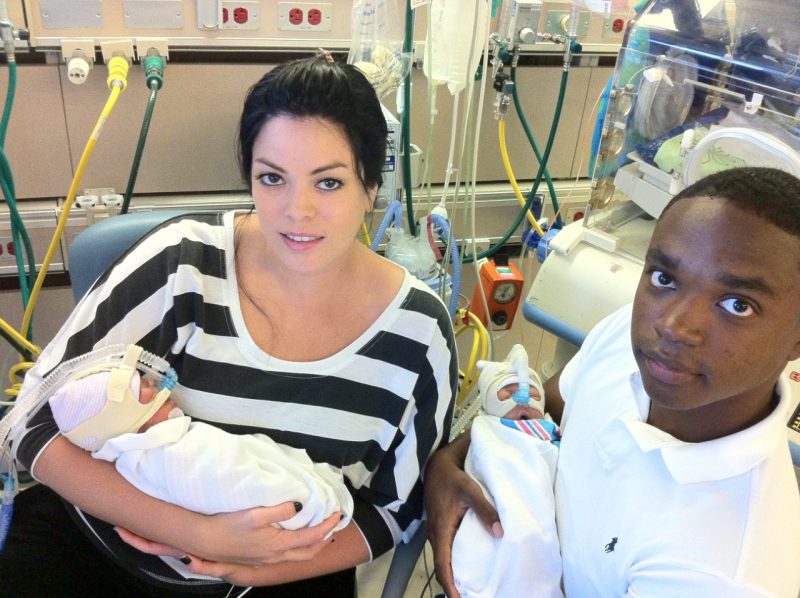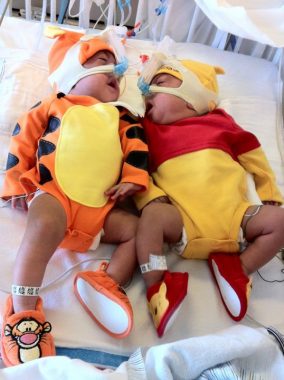Rare Myopathy Affects Women, Too, Advocate Emphasizes

Photo courtesy of Ashley Walker
Ashley and Johnny Walker hold their twin boys, Alexander and Jayden, who were diagnosed with x-linked myotubular myopathy.
After being diagnosed as a carrier of x-linked myotubular myopathy (XLMTM) and losing her infant twin boys to the disease, Ashley Walker was driven into an episode of alcoholism.
What she didn’t know then was that her liver was affected severely by the disease, which eventually resulted in an emergency room visit for pancreatitis (inflammation of the pancreas). After gallbladder removal surgery, she vowed to change her outlook on life.
“I found the strength when I woke up that I’m going to fight this [XLMTM] even if it kills me,” Walker, 32, said in an interview with Muscular Dystrophy News.
XLMTM is a rare disease characterized by muscle weakness, which can lead to difficulty walking, swallowing, and breathing. Patients with the severe form of the disease often experience respiratory failure. The disorder is more common and more severe in males, but some female carriers also exhibit symptoms.

Ashley Walker. (Photo courtesy of Ashley Walker)
Walker, who lives in Carlsbad, California, has trouble walking, standing for long periods of time, and holding her head up, but it hasn’t stopped her from being a voice to women and girls who are carriers or have XLMTM.
“I’m trying to gather my words for the females,” she said, emphasizing that she doesn’t want this advocacy to take away from males who are more severely affected by the disease. “It’s so crucial to give the girls just as much attention.”
In that vein, she is attending an Aug. 3 externally-led virtual U.S. Food and Drug Administration (FDA) Patient-Focused Drug Development meeting, organized by MTM-CNM Family Connection and Where There’s a Will There’s a Cure.
‘Connecting the dots’
When the geneticist called to confirm Walker’s diagnosis as she and her husband were driving to visit her children at a skilled nursing facility in San Diego in 2012, past incidents in her life, going back to her birth, made more sense.
“I felt like I was just connecting the dots,” Walker said. “So much makes sense now that I have this diagnosis.”
Walker said she had always compared herself with her older sisters, one 14 months older and the other nine years her senior, and they provided a baseline to chart her developmental progress. Everything looked normal until Walker started kindergarten.
At that age, she would pull an empty chair next to her to help rise from a seated position. Walker’s kindergarten teacher mentioned this anomaly to her mother and, after exhaustive testing, doctors decided she had limb-girdle muscular dystrophy. She would have that diagnosis until the real culprit was discovered, which didn’t happen until she was 24.
“I kind of gave up on doctors because it was always the same thing … and it just got repetitive and boring,” Walker said.

Alexander and Jayden wear Winnie the Pooh outfits in their care facility.
So, she lived her life as normal as possible, but she still became tired after long hikes and sometimes toppled to the ground for no reason other than a loss of strength, which affects only the left side of her body. Walker met her husband, Johnny, who was in the Marine Corps at the time, when she was 20, and they immediately started talking about having kids.
She looked back on her own life and felt she could raise children who had limb-girdle muscular dystrophy, not knowing at the time that the disease they would be born with was much worse. Most of Walker’s pregnancy was normal, but she went into labor much earlier than expected, delivering her sons, Alexander and Jayden, via emergency C-section on May 11, 2012.
The twins were moved immediately to an intensive care unit and had to use breathing and feeding tubes. Doctors assured her everything was normal; the baby boys just needed more time to grow. When that stopped being the case, the physicians’ attention turned to Walker, leading her on a journey to her real diagnosis.
Exactly 15 months later, Alexander and Jayden died together from a cold that turned into pneumonia. Their deaths eventually energized her to try to make a difference in the life she had, losing 100 pounds. She also made it her mission, by raising awareness and sharing her story, to ensure that other women with her condition were being diagnosed accurately and finding the support they needed.
Trapped in her body
At 15 years old, Walker discovered a love for fashion through her work experience class period; she landed a temporary job at Papaya, a girls clothing store. She continued in retail and became a manager at another fashion retailer, Juicy Couture, a couple of years later. That position worked better for her because it allowed her to be off her feet for long periods of time.
“That time was probably the best time of my life,” she said. “I was just me, without any help, without needing any permission.”
She eventually was forced to quit her job in 2013 because she could stand for only about 12 minutes. She tried to start classes at a Joe Blasco makeup school, but again it required standing too long.
The progressive nature of the disease has been the most difficult part of living with XLMTM, she says. “I feel like I’m trapped in this body and want to just jump out,” Walker said.
There are no approved therapies yet that directly target the underlying cause of XLMTM, and therapeutic strategies are aimed at only managing symptoms.
In search of something that could help her, Walker was ready to pack her bags for Europe, where biotechnology company Dynacure is conducting a Phase 1/2 clinical trial, called Unite-CNM (NCT04033159). The study is evaluating its potential disease-modifying therapy DYN101 in centronuclear myopathies, which is an umbrella term that covers XLMTM. The FDA accepted the company’s investigational new drug application for the experimental treatment in June.
Her doctors convinced Walker to stay and wait for a trial to open in the U.S., but she remains committed to finding a treatment no matter what.
“I am going to try it, whether it kills me or not. I am at that point where death doesn’t scare me,” Walker said. “Because I don’t want to live the way I’m living right now.”
A cure for her would mean walking on the beach again, cup of coffee in hand, running up the stairs at a baseball game, jumping in celebration when her team scores, not being stuck “like a bug” when she falls, and having to use a machine for ventilation at night. It would mean a return to the job she loves.
The biggest thing she would look forward to?
“Just being me.”







